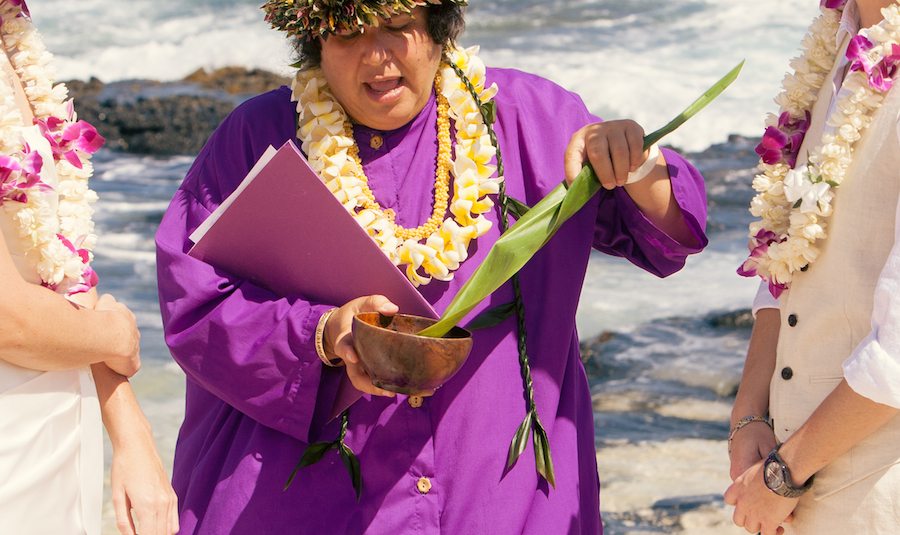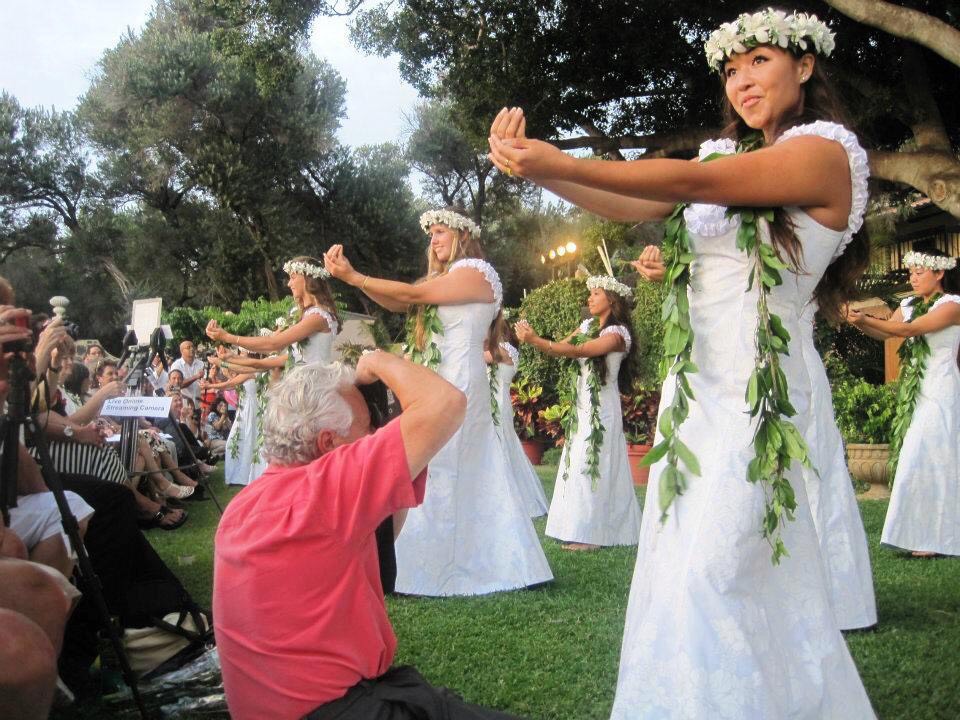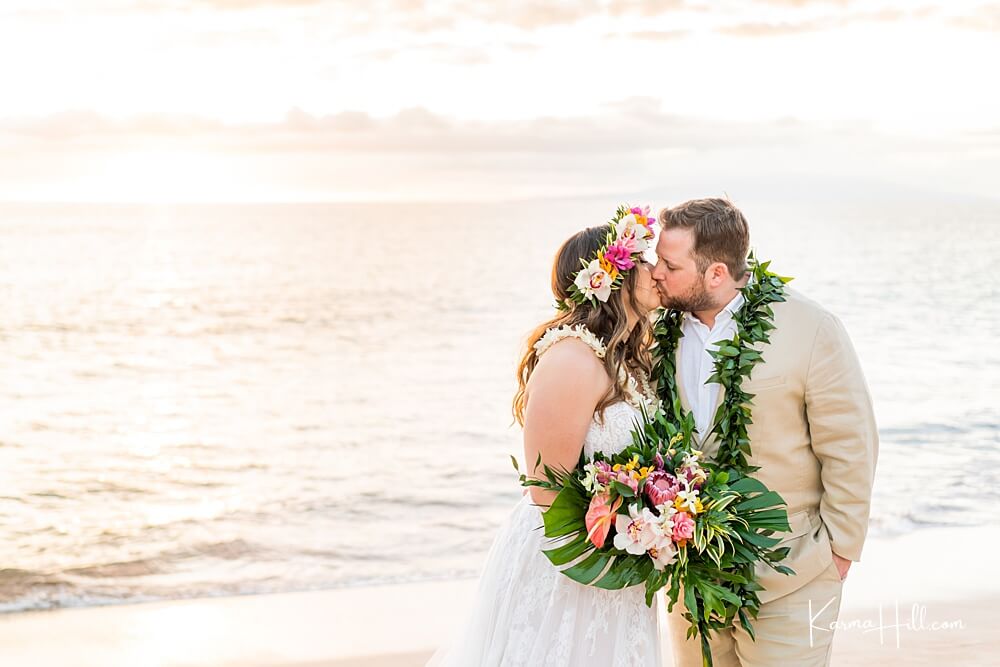Getting married on Hawaii Island is one of the biggest wishes in the life of many people around the world. The main reason is that there are a lot of interesting activities at a traditional Hawaiian wedding, such as Lei exchange, Hula dance, and The Pū. But do you know what happens in those activities? Let’s explore with us!
Blowing of The Pū – An Important Activity At Hawaiian Wedding

According to Mina Brightman, CEO of Cherished in Hawaii, blowing the conch shell horn, also known as the Pū, is an old Hawaiian tradition that was once used to signal the arrival of canoes, the entry of ali’i (Hawaiian nobility), and communication between adjacent towns. She explains that it is an old Hawaiian fanfare designed to draw attention to the importance of whatever is taking place. The Pū is used to convene a meeting, bless a home, and proclaim a marriage today.
To encourage attendees to take some time to ponder, many ministers opt to blow the Pū at the very beginning of the ceremony. Some decide to blow it when the couple enjoys their first kiss as husband and wife, though.
Lei Exchange

This is the most interesting activity at traditional Hawaiian wedding. Flower garlands known as leis represent love, esteem, and the Aloha spirit. Typically, grooms wear a garland of dapper green maile leaves (sometimes with small white flowers, called pikake, woven in). The local priest, also known as a kahuna pule or kahu (Hawaiian holy man), would bind the couple’s hands with a maile lei during a traditional Hawaiian wedding ceremony (more on that later). Several pink and white pikake strands, which can be intertwined with rosebuds or orchids, are frequently worn by brides. The bride could also have a haku flower and foliage headdress. At smaller weddings, some couples give one to each guest while others give their mums lei.
“Pili nai kealoha” means “love that binds,” according to Kunrow. In accordance with this custom, the celebrant ties the couple’s hands with a maile lei as they recite an accompanying oli. The dark green vines that are woven together to make the maile lei are used. Brightman claims that pikake or white orchids are occasionally used as decorations. She claims that the maile lei is among the earliest lei types and is consequently rich in heritage and cultural value. It is referred to as the royal lei and represents steadfast love, a wish for peace, and respect. She continues by saying that this custom may be seen as the Hawaiian equivalent of the sand or candle ceremony.
You can read The 7 Most Popular Lei in Hawaii and What Makes Them Special
Hawaiiain Ring Blessing – The Most Sacred Acitivity Of The Wedding Ceremony

Due to the need for water, the Hawaiian ring blessing is often only performed during beach weddings. Wagner explains that under this custom, both rings are put in a Hawaiian wood bowl. The groom then takes a conch shell that has water inside it while the bride holds the bowl. By dipping a leaf in the conch shell’s salt water and scattering it over the rings, the minister blesses them.
The Oli Aloha

The “Oli Aloha” chant customarily initiates the Hawaiian ceremony. An oli is a chant intended to elevate and prepare a place or individuals for blessing or to be welcomed in, according to Pastor Mark Kunrow, a Hawaiian reverend (and a winner of The Knot Best of Weddings). According to Wagner, this oli extends a word of greeting to both the couple and the visitors. “A portion of it reads, “There was a loved one seeking, now she is found.” You two are about to unite, “Wagner argues. Aloha and the welcome phrase “E komo mai” are said at the end.
“He alo he alo”, according to Kunrow, means “face to face.” According to Brightman, “This oli signals the conclusion of the ritual and is a prayer for the couple to share aloha in their union and to celebrate the breath of life that is given to us.” “Alo” means “person” and “Ha” means “breath”, according to Junrow.
Hula – A Popular Dance At Traditional Wedding

Ancient times are when the hula dance first became popular. The graceful, mesmerizing dance portrays a range of feelings and natural phenomena. There are numerous ways to execute the hula at a traditional wedding: occasionally, the bride will dance it for the husband; other times, the couple will engage a group of dancers to perform the hula throughout the ceremony.
Read more Facts about Hula in Hawaii you may be shocked to hear
Activities at traditional Hawaiian wedding are rich in aloha culture. The aloha spirit is transmitted through cultural customs, language, music, hula, food, and artifacts. It is defined as the sharing of the essence of life through love, peace, kindness, and compassion. The Hawaiian islands are unique because of their connection to nature and to generational tradition. Hope this article will be useful to those who intend to celebrate a traditional Hawaiian wedding.

Loved the articles. Should I be lucky enough to find a good husband, I’d love a Hawaiian ceremony
Howdy! Do you use Twitter? I’d like to follow you if that would be okay. I’m absolutely enjoying your blog and look forward to new posts.
Thanks for your whole hard work on this site. My aunt really loves getting into investigation and it’s really obvious why. All of us know all regarding the compelling manner you create helpful tactics through this blog and in addition attract response from the others about this area then our own simple princess is in fact discovering a lot of things. Take pleasure in the rest of the year. You are conducting a wonderful job.